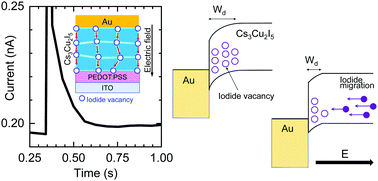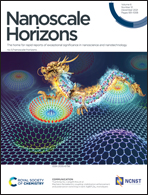Asymmetric carrier transport in flexible interface-type memristor enables artificial synapses with sub-femtojoule energy consumption†
Abstract
Flexible and transparent artificial synapses with extremely low energy consumption have potential for use in brain-like neuromorphic electronics. However, most of the transparent materials for flexible memristive artificial synapses were reported to show picojoule-scale high energy consumption with kiloohm-scale low resistance, which limits the scalability for parallel operation. Here, we report on a flexible memristive artificial synapse based on Cs3Cu2I5 with energy consumption as low as 10.48 aJ (= 10.48 × 10−18 J) μm−2 and resistance as high as 243 MΩ for writing pulses. Interface-type resistive switching at the Schottky junction between p-type Cu3Cs2I5 and Au is verified, where migration of iodide vacancies and asymmetric carrier transport owing to the effective hole mass is three times heavier than effective electron mass are found to play critical roles in controlling the conductance, leading to high resistance. There was little difference in synaptic weight updates with high linearity and 250 states before and after bending the flexible device. Moreover, the MNIST-based recognition rate of over 90% is maintained upon bending, indicative of a promising candidate for highly efficient flexible artificial synapses.



 Please wait while we load your content...
Please wait while we load your content...